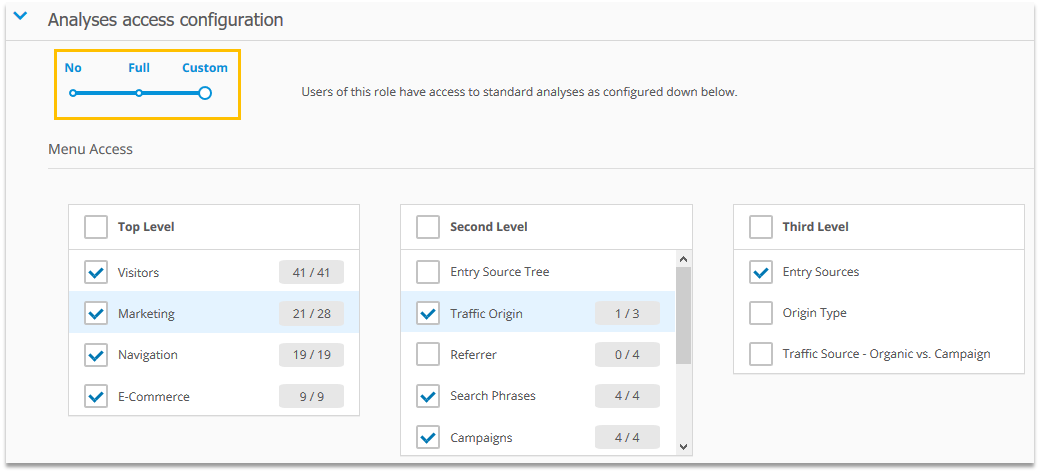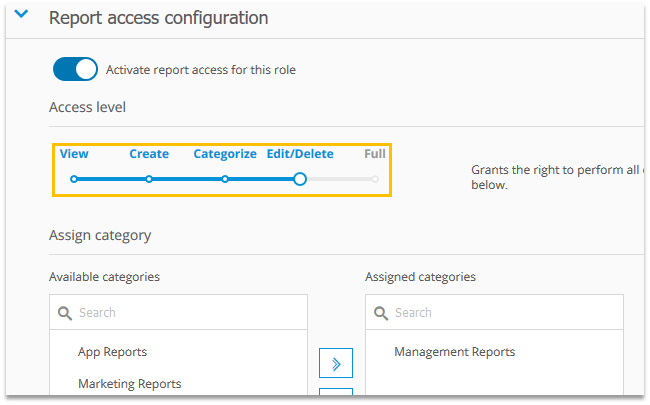User Management > Roles > Create New Role / Edit Role
Using roles, you can define which access rights a user has. A User can be assigned to more than one role; also, multiple users can be assigned to one role.
Basic role configuration
| Role Name: | Is used to easily identify the role in the user management. |
| Role Description: | Allows for a detailed description of roles. |
Account assignment
Choose which accounts a user in this role may access.
Account configuration
Here you can choose which products users can access in this role. The chosen products are always available for all accounts chosen at "Account assignment".
Only these products are available which are part of your contract. For further questions, please contact our Support.
User assignment
Choose which users are assigned to this role.
Alternatively, users can be assigned to a role within the "Users" area.
Analyses access configuration
Choose which analyses are shown in the Analytics main menu.

- No: Users of this role do not have access to standard analyses.
- Full: All analyses are shown to users of this role.
- Custom: For each analysis, it can be determined whether users of this role have access to it.
If access is granted on the top level or second level, access will also automatically be granted for newly created analyses.
Example: If you grant access to Navigation > Content Groups, then all Content Groups are shown in the main menu for users assigned to this role. If a new Content Group is created, it will also be shown in the analysis.
Report access configuration
For each role, the access level for reports can be defined. Further, categories are assigned to each role. The access level applies for all categories that are assigned to a role

- View: Read permission for reports shared with this login
- Create: + Creating own reports
- Categorize: + Assign report to categories
- Edit/Delete: + Edit and Delete
- Full Access: All rights for every report (also private reports!)
Please note: If a user is assigned to multiple roles, the rights of these roles are merged.
Example: A user has the right "View" for the category "Marketing" in one role, and in another role, the right "Edit/Delete" for this category. In this case, he may edit and delete reports of this category.
Custom figures access configuration
Administration of custom metrics and formulas
Choose whether users can create, edit, or delete custom metrics or formulas.
Even if this option is not activated, custom figures still are available in analyses and reports.
Metrics and dimensions access configuration
- Full: The user has access to all metrics and dimensions.
- Custom: Users in this role have access only to the selected dimensions and metrics.
If you want to set access individually, only select the metrics and dimensions that should be visible for a user in this role. You also can select or unselect complete groups of metrics and dimensions.

For each unselected dimension or metric (i.e., dimensions and metrics that will not be visible for the user), the following rules apply:
- The dimension/metric cannot be added to any analysis.
- If a dimension/metric is part of a predefined analysis, it will be hidden there. A user can still see the analysis as long as it contains at least one visible dimension and metric.
- Rule 2 also applies for saved analyses (i.e., analyses at "My Analyses" or within reports).
If an analysis contains a filter with a hidden dimension or metric, the whole analysis will be hidden. - Within reports, the following things hold: Elements that contain at least one hidden dimension or metric cannot be edited by the user. However, he may still see analyses according to the previously mentioned rules.
- Custom Formulas and Metrics are hidden if they contain at least one hidden metric or dimension.
Please note: Changing the access rights for metrics and dimensions can have the effect that also within saved reports, certain elements are not visible anymore for specific users. Reports sent via scheduled dispatch always show the view of the user who set up the export.
Further Information:
- How-To: User Management: Basic Use Case
- How-To: User Management: Extended Use Case
- How-To: How to hide specific dimensions and metrics for users